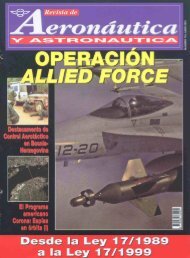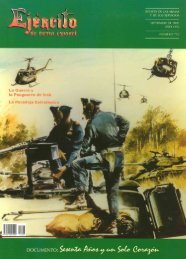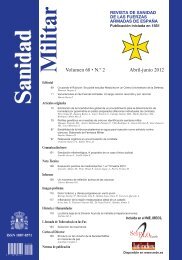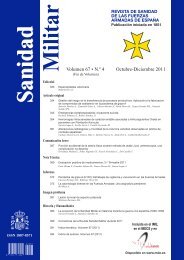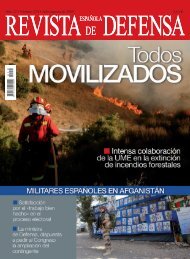ada 10 mm 4/4/08 15:33 Página 1 - Portal de Cultura de Defensa ...
ada 10 mm 4/4/08 15:33 Página 1 - Portal de Cultura de Defensa ...
ada 10 mm 4/4/08 15:33 Página 1 - Portal de Cultura de Defensa ...
You also want an ePaper? Increase the reach of your titles
YUMPU automatically turns print PDFs into web optimized ePapers that Google loves.
D E F I N I C I O N E S P a l a b r a s<br />
G.— Arq. Nav.: Embarcación malaya <strong>de</strong> formas parecidas a las<br />
europeas y velas <strong>de</strong> quechemarín. . . . . . . . . . . . . . . . . . . . . . . .<br />
H.— Biol.: Denominación colectiva <strong>de</strong> las porciones muertas <strong>de</strong><br />
una comunidad vegetal, todavía no convertidas en humus o en<br />
s a p r ó p e l o . . . . . . . . . . . . . . . . . . . . . . . . . . . . . . . . . . . . . . . . .<br />
I . — Constr. Nav.: Punto más convexo y saliente <strong>de</strong> la cua<strong>de</strong>rna<br />
maestra, y la cabeza o extremo <strong>de</strong> c<strong>ada</strong> pern<strong>ada</strong> <strong>de</strong> varenga . .<br />
J.— Bot: Árbol leguminoso <strong>de</strong> las islas Filipinas; su ma<strong>de</strong>ra, dura,<br />
correosa e incorruptible, se usaba en las obras <strong>de</strong> capintería en<br />
blanco <strong>de</strong> los buques . . . . . . . . . . . . . . . . . . . . . . . . . . . . . . . . .<br />
K.— Man.: Tejido que suele hacerse a bordo <strong>de</strong> los buques con<br />
meollar o cordones <strong>de</strong> cabo. . . . . . . . . . . . . . . . . . . . . . . . . . . . .<br />
L.— Man.: Red o seno <strong>de</strong> cabo o <strong>de</strong> cable que se arrastra por el<br />
fondo <strong>de</strong>l mar para buscar los objetos sumergidos . . . . . . . . . .<br />
M.—Org.: Hombre <strong>de</strong> leva o que servía a bordo, cogido <strong>de</strong> leva . . .<br />
N.— Man.: La troza principal que más junta el racamento con el<br />
palo o verga (<strong>de</strong>nominación antigua). . . . . . . . . . . . . . . . . . . . .<br />
O.— Geo. e Hist.: Ciudad y puerto <strong>de</strong> Turquía, sobre el mar Egeo.<br />
Se ejecutaron acciones navales contra ella en 1344, 1472 y<br />
1770 . . . . . . . . . . . . . . . . . . . . . . . . . . . . . . . . . . . . . . . . . . . . . .<br />
P.— Hidr.: Montecillo costero con la cima horizontal y <strong>de</strong>stac<strong>ada</strong> . .<br />
Q.— Mar. Rec.: Monotipo finés, <strong>de</strong> manejo simple y sencillo por su<br />
reducido velamen. Lento y poco maniobrero. . . . . . . . . . . . . . .<br />
R.— Hidr.: Corriente <strong>de</strong> agua que va a <strong>de</strong>sembocar en otra, en un<br />
lago o en el mar . . . . . . . . . . . . . . . . . . . . . . . . . . . . . . . . . . . . .<br />
S.— Biol.: Sustancia muy abundante en las algas pardas . . . . . . . . .<br />
T.— Hidr.: Río <strong>de</strong> España, en las provincias <strong>de</strong> Gerona y Barcelona,<br />
nace en los Pirineos y tiene un curso <strong>de</strong> 167 km. Un dragaminas<br />
llevó su nombre . . . . . . . . . . . . . . . . . . . . . . . . . . . . . . . . . .<br />
U.— Org.: Siglas <strong>de</strong> una antigua especialidad <strong>de</strong> la Arm<strong>ada</strong>. . . . . . .<br />
52 81 5 28 31 38<br />
37 12 40 34 <strong>10</strong>4 45<br />
43 21 <strong>10</strong>3 32 39<br />
4 16 25 13<br />
86 67 58 94 61 56<br />
66 <strong>10</strong>7 30 73 47 20<br />
<strong>10</strong>0 65 7 59<br />
<strong>10</strong>9 50 69 82 88 89<br />
51 55 62 35 97 92<br />
70 54 64 90 79 63<br />
76 8 68 93<br />
1<strong>10</strong> 87 71<br />
19 <strong>10</strong>2 83 84<br />
<strong>10</strong>6 91 80<br />
95 <strong>10</strong>1<br />
20<strong>08</strong>] 485<br />
42<br />
49<br />
77<br />
74





